officially the
Republic of Turkey (Turkish:
Cumhuriyeti (help·info); pronounced [ˈtyɾcije d͡ʒumˈhuɾijeti]),
is a transcontinental country in Eurasia, mainly in Anatolia
in Western Asia, with a smaller portion on the Balkan
peninsula in Southeast Europe.
Turkey is a democratic, secular, unitary, parliamentary
republic with a diverse cultural heritage. Turkey is bordered
by eight countries: Greece and Bulgaria to the northwest;
Georgia to the northeast; Armenia,
the Azerbaijani exclave of Nakhchivan and Iran to
the east; Iraq and Syria to the south. The country is encircled
by seas on three sides: the Aegean Sea is to the west, the Black
Sea to the north, and the Mediterranean Sea to the south.
The Bosphorus, the Sea of Marmara, and the Dardanelles,
which together form the Turkish Straits, divide Thrace and
Anatolia; they also separate Europe and Asia. Ankara is the
capital while Istanbul is the country's largest city and main
cultural and commercial centre. Approximately 70-80% of
the country's citizens identify themselves as ethnic Turks.
[ Other ethnic groups include legally
recognised[II (Armenians, Greeks, Jews) and unrecognised (Kurds, Arabs, Circassians, Albanians, Bosniaks,
Georgians, etc.) minorities. Kurds are the largest ethnic
minority group, making up approximately 20% of the
population.
https://en.wikipedia.org/wiki/Turkey
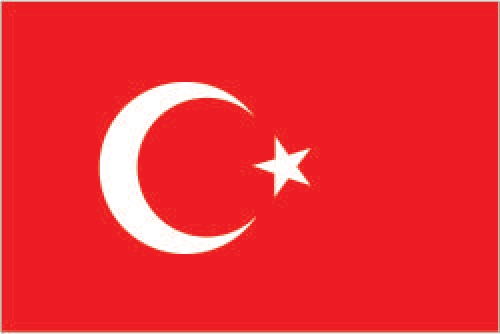
The crescent and star became associated with Islam
when the Muslim Turkic peoples of Central Asia captured
the Anatolian peninsula (and, eventually, Constantinople)
and added the crescent and star of the latter to their own
plain red flags. There were several Turkish flags
throughout the centuries of the Ottoman Empire, most of
them incorporating the crescent and star and the colours
red or green.
In June 1793 the flag now used as the Turkish national
flag was established for the navy, although its star had
eight points instead of the current five. The reduction in
the number of star points was made about 1844. That
flag design was reconfirmed as the Turkish national
banner on June 5, 1936, following the revolution led by
Atatürk, who had established a republic in 1923 after
the collapse of the Ottoman dynasty.
https://www.britannica.com/topic/flag-of-Turkey

Mor og Jan Erik kommer ut fra flyet.

En ettermiddag med uvær. Lyn, torden og vind.
Bildet er tatt fra rommet vårt på hotellet.

Grete med den Blå Moske i bakgrunnen
The Blue Mosque (Called Sultanahmet Camii in Turkish)
is an historical mosque in Istanbul. The mosque is known
as the Blue Mosque because of blue tiles surrounding the
walls of interior design.Mosque was built between 1609
and 1616 years, during the rule of Ahmed I. just like many
other mosques, it also comprises a tomb of the founder, a
madrasa and a hospice.Besides still used as a mosque, the
Sultan Ahmed Mosque has also become a popular
tourist attraction in Istanbul.
http://www.bluemosque.co/

Mor filmer med Hagia Sophia i bakgrunnen.
Hagia Sophia is a great architectural beauty and an
important monument both for Byzantine and for
Ottoman Empires.
Once a church, later a mosque, and now a museum at
the Turkish Republic, Hagia Sophia has always been
the precious of its time..
Rebuilt by the orders of Emperor Justinian in 537, for
900 years Hagia Sophia had been the center of
Orthodox Christianity until 1453 when the city was
concurred by Ottomans. 500 years following the
conquest of Muslims, it became a jewel for the Muslim
world and as the grand mosque of the sultans.
http://www.hagiasophia.com/
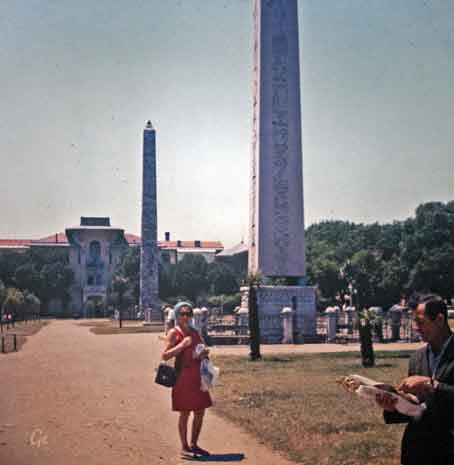
Hipodromen med to obelisker
Right:
Ortaköy Mosque (Turkish: Ortaköy Camii), officially the
Büyük Mecidiye Camii (Grand Imperial Mosque of Sultan
Abdülmecid) in Beşiktaş, Istanbul, Turkey, is situated at
the waterside of the Ortaköy pier square, one of the most
popular locations on the Bosphorus.
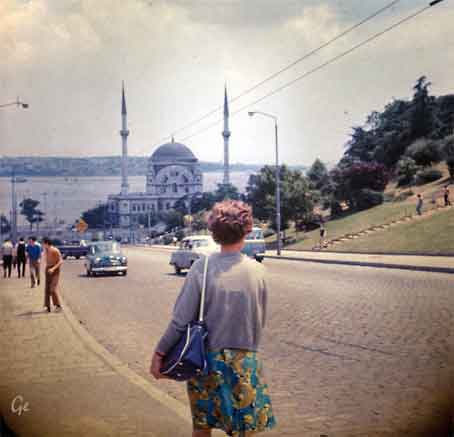
On this site, a masjid commissioned by the son-in-law of
Vizier Ibrahim Pasha used to stand. Built in 1721, it was
ruined during the Patrona Halil Uprising. The current
mosque, which was erected in its place, was ordered by the Ottoman sultan Abdülmecid and built between 1854
and 1856, on the ruins of the Cantemir Palace.
Its architects were Armenian father and son Garabet
Amira Balyan and Nigoğayos Balyan (who also designed
the nearby Dolmabahçe Palace and the Dolmabahçe
Mosque), who designed it in the Neo-Baroque style.
https://en.wikipedia.org/wiki/Ortak%C3%B6y_Mosque
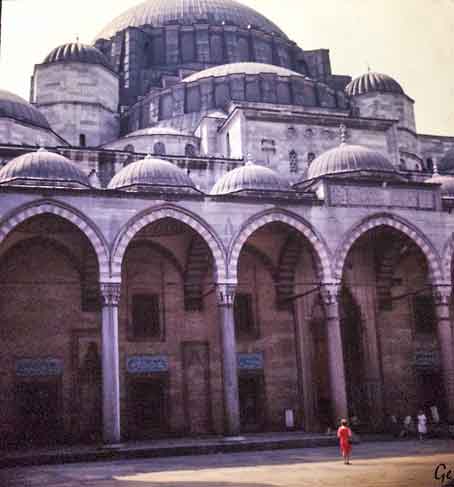
Mor blir liten utenfor Soleimanmoskeen.
| The Süleymaniye Mosque,
built on the order of Sultan Süleyman (Süleyman the Magnificent), “was fortunate to be able to draw on the talents of the architectural genius of Mimar Sinan” (481 Traditions and Encounters: Brief Global History). The construction work began in 1550 and the mosque was finished in 1557. |
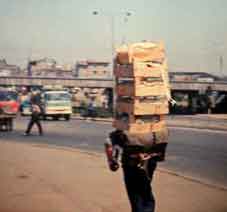 Noen har tungt arbeide |
Islamic and Byzantine architectural elements. It combines tall, slender minarets with large domed buildings supported by half
domes in the style of the Byzantine church Hagia Sophia
(which the Ottomans converted into the mosque of Aya Sofya)”
(481 Traditions and Encounters: Brief Global History).
Suleymaniye Mosque Istanbul - Istanbul - Visit Istanbul (6. juli 2022)
Istanbul (Turkish: İstanbul) is Turkey's most populous city
as well as its cultural and financial hub. Located on both
sides of the Bosphorus, the narrow strait between the
Black Sea and the Marmara Sea, Istanbul
bridges Asia and Europe both physically and culturally.
Istanbul's population is estimated to be between
12 and 19 million people, making it also one of the
largest cities in Europe and the world.
http://wikitravel.org/en/Istanbul
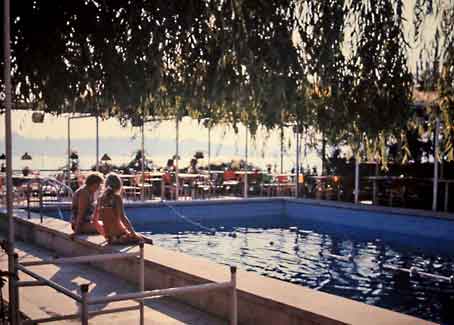
Bassenget på hotel Harem, 1971
Best view of the Bosphorus
A Place of pleasure for discovering the beauty of
Istanbul while avoiding the chaos of the modern city.
The Harem Hotel offers you a great Istanbul experience
with its quality of service, comfort and unique panorama...
Staying at Harem Hotel in Istanbul will allow you to enjoy
the best of what Istanbul has to offer.
http://www.haremhotel.com/en/index.html
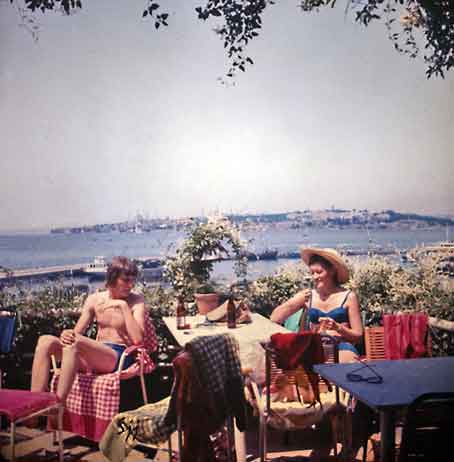
Grete og Jan Erik ved bassenget på hotellet.
Rett nedenfor hotellet gikk fergene over til den
europeiske delen av Istanbul.
Vi besøkte flere steder i Istanbul enn det er bilder fra her.
Fotografering var dyrt den gang, og utstyret dårligere.
Lebanon (
pronunciation: [lɪbˈnæːn]; French: Liban), officially known
as the Lebanese Republic (Arabic: الجمهورية اللبنانية
al-Jumhūrīyah al-Lubnānīyah; Lebanese pronunciation:
[elˈʒʊmhuːɾɪjje l.ˈlɪbnæːnɪjje]; French: République libanaise),
is a sovereign state in Western Asia. It is bordered by Syria
to the north and east and Israel to the south, while Cyprus
is west across the Mediterranean Sea. Lebanon's location
at the crossroads of the Mediterranean Basin and the
Arabian hinterland facilitated its rich history and shaped
a cultural identity of religious and ethnic diversity.
At just 10,452 km2 (4,036 sq. mi.), it is the smallest r
ecognized country on the entire mainland Asian continent.
The earliest evidence of civilization in Lebanon dates back
more than seven thousand years, predating recorded history.
Lebanon was the home of the Canaanites/Phoenicians and
their kingdoms, a maritime culture that flourished for over
a thousand years (c. 1550–539 BC).
In 64 BC, the region came under the rule of the Roman
Empire, and eventually became one of the Empire's leading
centers of Christianity.
In the Mount Lebanon range a monastic tradition known as
the Maronite Church was established. As the Arab Muslims
conquered the region, the Maronites held onto their religion
and identity. However, a new religious group, the Druze,
established themselves in Mount Lebanon as well, generating
a religious divide that has lasted for centuries.
During the Crusades, the Maronites re-established contact
with the Roman Catholic Church and asserted their
communion with Rome. The ties they established with the
Latins have influenced the region into the modern era.
https://en.wikipedia.org/wiki/Lebanon
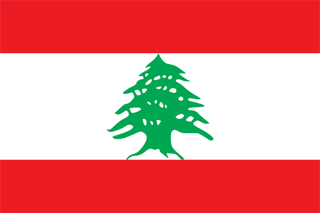
The national flag of Lebanon was adopted on
December 7, 1943.
The red bands on top and bottom symbolize the
pure blood shed in the fight for freedom, the
white for peace and the mountain snow, and the
green cedar is symbolic of immortality and
steadiness.
http://www.worldatlas.com/webimage/
countrys/asia/lebanon/lbflags.htm
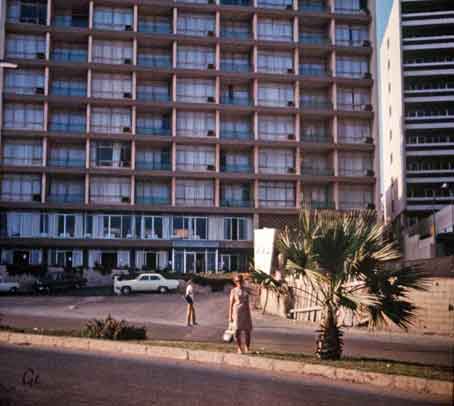
Hotel Dolphin i Beirut
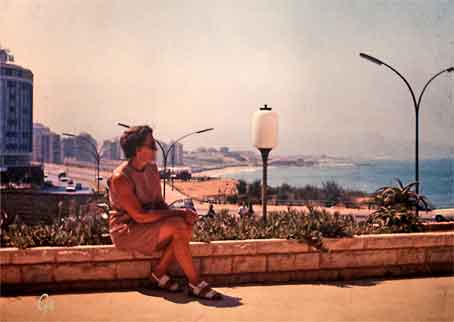
Mor sitter på terrassen på hotellet.
Fin utsikt, men det var vel det eneste
som var fint ved dette hotellet.
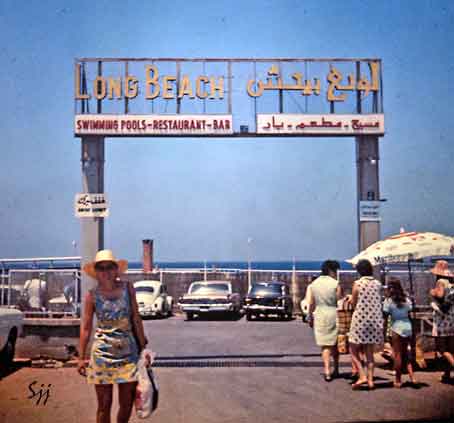
Grete ved inngangen til Long Beach.
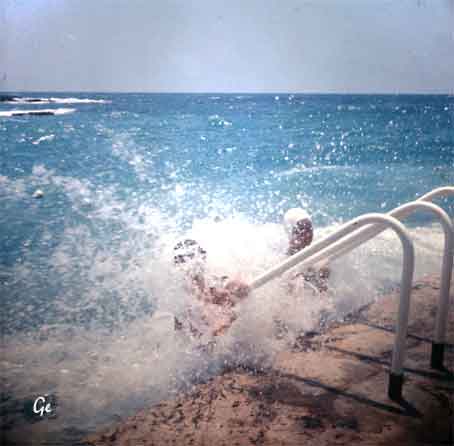
Bølgene er kraftige.
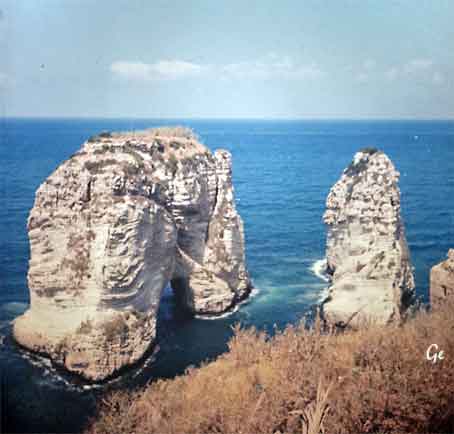
Dueklippene
- Pigeon Rocks (Rawcheh District) A monumental
natural arch
- jutting up from the Mediterranean.
Great place to sit at one of
- the roadside cafes and watch the sun
set.There is a trail that
- leads in the beach in front of the
Rocks.Locals are offering
- boat ride in and around the Rocks
with small fishing boats.
- If you dare enough to trust them go but deal the price from
- the start in order you not overcharged.
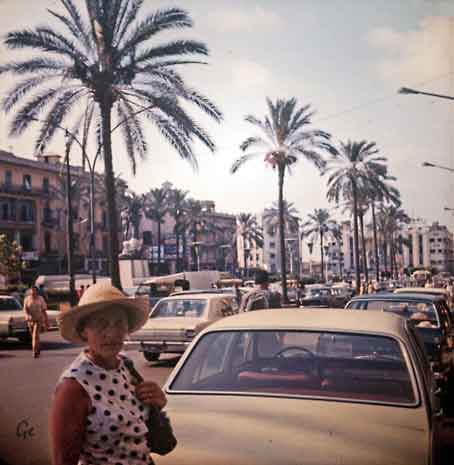
Mor på Martyrplassen i Beirut.
In 1931, the historic square took its name to
commemorate the martyrs executed there under
Ottoman rule.
In the 1950s the square became a popular venue
for cinemas and coffee-houses.
During the Lebanese Civil War, it formed the
demarcation line that divided the city in half.
https://en.wikipedia.org/wiki/Martyrs%27_Square,_Beirut

Flyktningeleir i Beirut
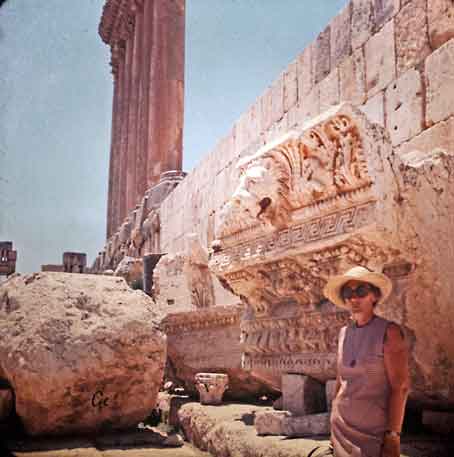
Baalbek tempel i Libanon
now modern day Lebanon, north of Beirut, in the Beqaa
Valley.
Inhabited as early as 9000 BCE, Baalbek grew into an
important pilgrimage site in the ancient world for the
worship of the Phoenician sky-god Baal and his consort
Astarte, the Queen of Heaven (the name `Baalbek' means
Lord Baal of the Beqaa Valley). The center of the city
was a grand temple dedicated to Astarte and Baal and
the ruins of this early temple remain today beneath the
later Roman Temple of Jupiter Baal.
to weigh over 100 tons and the retaining wall monoliths
weigh, each, 300 tons, leaving present-day archaeologists,
scientists and historians mystified as to how the stones
were moved, where from, and in what way they could
have been manipulated into place. These blocks, and
another one mile from Baalbek which weighs over 900
tons, are known today as the Baalbek Stones and have
been the subject of much debate, study and conjecture
over how they were moved and arranged.
Later builders at the site, such as the Romans, used these
early stones as the foundations for their own temples but
clearly did not move them in any way.
http://www.ancient.eu/Baalbek/
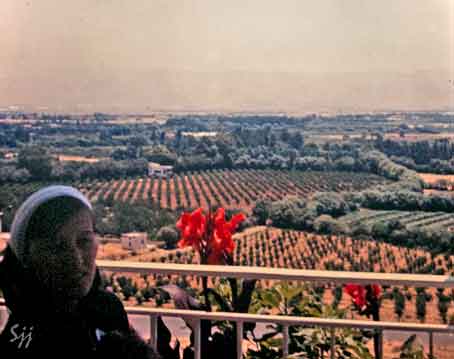
Bekaadalen (eller Kanaans land).
Vi er på restauranten La Gondole.
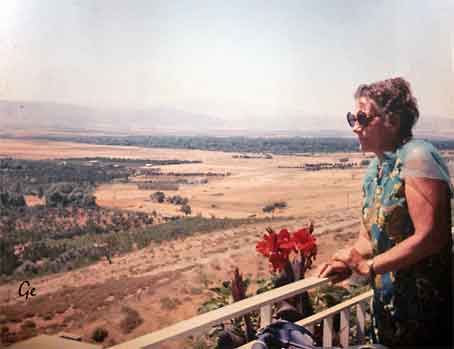
Mor på restaurant La Gondole
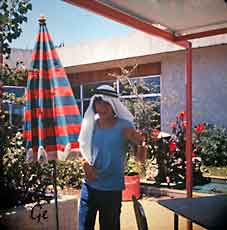 Jan som sheik på La Gondole |
The
elongated plateau of the Beqaa Valley is known for its warm and dry summers and cold and wet - even snowy - winters. Covered with olive groves, cultivated wheat fields and large numbers of vineyards, figs and pomegranate trees, |
agricultural region.
Predominantly Shi’ite, the Beqaa Valley is considered traditional
and poor and on many occasions, it negatively has been
associated with Hezbollah having their headquarters there.
Due to the latter, the area suffered greatly from the 2006
Israel War.
http://www.living-lebanon.com/beqaa-valley.html
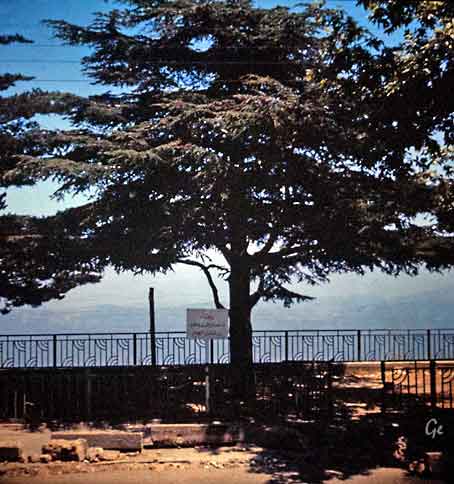
Sedertre
The mountains of Lebanon were once shaded by thick
cedar forests and the tree is the symbol of the country.
After centuries of persistent deforestation, the extent
of these forests has been markedly reduced.
https://en.wikipedia.org/wiki/Cedars_of_God
Syria (
Syrian Arab Republic (Arabic: الجمهورية العربية السورية
al-Jumhūrīyah al-ʻArabīyah as-Sūrīyah),
is a country in Western Asia, bordering Lebanon and the
Mediterranean Sea to the west, Turkey to the north, Iraq to
the east, Jordan to the south, and Israel to the southwest.
Syria's capital and largest city is Damascus.
A country of fertile plains, high mountains, and deserts, Syria is
home to diverse ethnic and religious groups, including Syrian Arabs, Greeks, Armenians, Assyrians, Kurds, Circassians,
Mandeans and Turks. Religious groups include Sunnis, Christians, Alawites, Druze, Mandeans, Shiites,
Salafis, and Yazidis. Sunni Arabs make up the largest
religious group in Syria.
https://en.wikipedia.org/wiki/Syria
Damascus (Arabic: دمشق Dimashq [dɪˈmaʃq], Syrian: [dɪˈmɪʃeʔ])
is the capital and likely the largest city of Syria, following the
decline in population of Aleppo due to the ongoing battle for
the city.
It is commonly known in Syria as ash-Sham
(Arabic: الشام ash-Shām) and nicknamed as the
City of Jasmine (Arabic: مدينة الياسمين Madīnat al-Yāsmīn).
In addition to being one of the oldest continuously
inhabited cities in the world, Damascus is a major
cultural and religious centre of the Levant.
The city has an estimated population
of 1,711,000 as of 2009.
https://en.wikipedia.org/wiki/Damascus
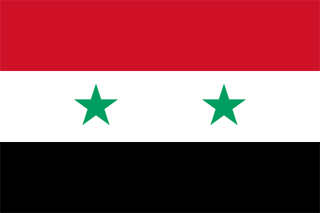
Syria's flag, inspired by the French Tricolor,
uses the Pan-Arab colors of green, red, white and black.
The two stars - (depending on the
point-of-view) -
either represent Syria and Egypt, or Syria and Iraq.
countrys/asia/syria/syflags.htm
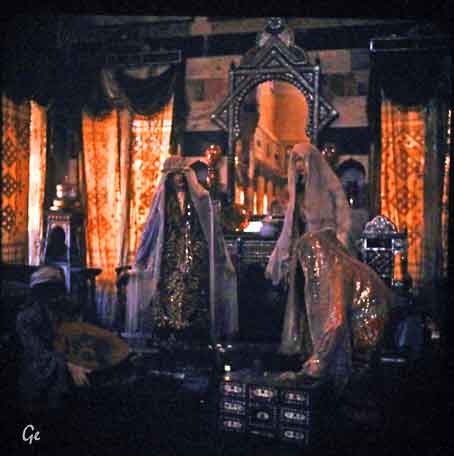
Jeg tror dette er fra Azm Palass i Damascus
Azm Palace (Arabic: قصر العظم) is a palace in Damascus,
Syria which was originally built in 1750 as a residence
for the Ottoman governor of Damascus
As'ad Pasha al-Azm.
The palace now houses the Museum of Arts and
Popular Traditions.
The architecture is an excellent example of Damascene
traditional houses. The structure consists of several
buildings and two wings: the harem and the selamlik.
The harem is the family wing, which was a private
space for the residents (originally, the Azm family).
This wing includes the kitchen, servant quarters, and
the baths, which are a replica of the public baths in the
city on a smaller scale. The salamlik is the guest wing,
and it comprises the formal halls, reception areas and
large courtyards with traditional cascading fountains.
Used in the building of this palace were several types
of stones including limestone, sandstone, basalt, and
marble, chosen to provide a natural decoration.
The ceilings have painted wooden
panels that display natural scenes.
https://en.wikipedia.org/wiki/Azm_Palace
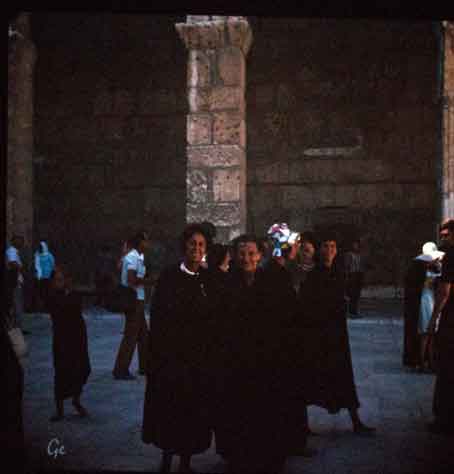
Moskebesøk i Damascus. Alle fikk svarte kapper.
The Umayyad Mosque
The Great Umayyad Mosque remains one of the great
symbols of the glorious period of Muslim civilisation and
its pride. It is a master piece of architectural ingenuity
having a decisive influence on the maturity of mosque
architecture all over the Muslim World.
The mosque was the birth place of a number of key
elements in Muslim architecture such as the horseshoe
arch, the square minaret and the Maqsurah.
Historically and culturally it is still one of the oldest and
holiest shrines of Islam.
Historic sources revealed that the building work started in
year 87 AH (705 CE) and was accomplished in year
96 AH (714), costing the Caliphate the whole income from
the land Kharaj8 of 7 successive years (Ibn Al-Faqih,
chapter 1, pp.106-108). Al-Idrissi, however, quoting Arab
sources, indicated that the cost reached the Kharaj of two
successive years only.
The Great Umayyad Mosque - Muslim HeritageMuslim Heritage
(6. juli 2022)
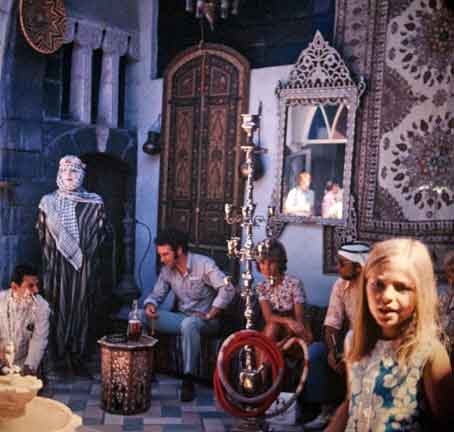
Hos en teppehandler
| Litt
handling blir det jo. |
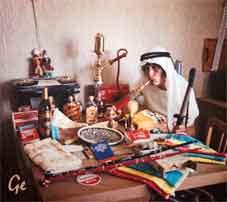 |